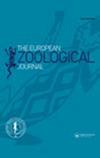On the interplay between phylogeny and environment on behaviour of two urban bird species, Columba livia and Corvus corone (Aves)
引用次数: 5
Abstract
Abstract Different hypotheses exist to explain the ability of individuals or species to modify their behaviours in response to the urban environment. Our study addresses risk-taking in urban birds as an essential behavioural change in cities allowing the species to manage living in anthropic habitats. Specifically, we tested role of phylogeny and the environment on risk-taking, expressed in lower escape distances. We adopted a comparative approach and compared the flight distance of urban pigeons and urban crows in Paris with rural wild rock doves and crows in Sardinia, thus contrasting environmental conditions (urban or rural), species (columbids vs. corvids) and type (feral or wild). Pigeons had lower flight distance than crows in both rural and urban environments, and rural individuals of both species had higher flight distance than urban individuals. However, this intraspecific difference was higher in pigeons than in crows, and the interspecific difference was higher in urban than in rural areas. Our study shows that risk-taking in birds is the outcome of a complex interplay between several environmental and phylogenetic factors, and confirms the hypothesis of increased risk-taking in urban pigeons as a result of a pre-adaptation due to artificial selection, as often suggested but never scientifically demonstrated.两种城市鸟类系统发育与环境对鸟类行为的影响
对于个体或物种改变自身行为以适应城市环境的能力,存在着不同的假说。我们的研究将城市鸟类的冒险行为视为城市中必不可少的行为变化,使物种能够在人类栖息地中生存。具体来说,我们测试了系统发育和环境对冒险的作用,表现在较低的逃跑距离上。我们采用比较方法,将巴黎城市鸽子和城市乌鸦的飞行距离与撒丁岛农村野生岩鸽和乌鸦的飞行距离进行了比较,从而对比了环境条件(城市或农村)、物种(柱头类与鸦类)和类型(野生或野生)。在农村和城市环境中,鸽子的飞行距离都低于乌鸦,而农村个体的飞行距离都高于城市个体。但是,种内差异在鸽子中高于乌鸦,种间差异在城市地区高于农村地区。我们的研究表明,鸟类的冒险行为是多种环境和系统发育因素复杂相互作用的结果,并证实了城市鸽子冒险行为增加是由于人工选择导致的预适应的假设,这一假设经常被提出,但从未得到科学证明。
本文章由计算机程序翻译,如有差异,请以英文原文为准。
求助全文
约1分钟内获得全文
求助全文

 求助内容:
求助内容: 应助结果提醒方式:
应助结果提醒方式:


